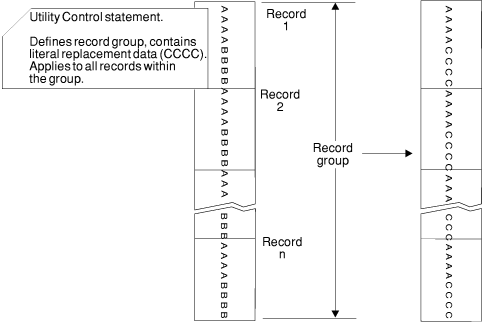 z/OS DFSMSdfp Utilities
z/OS DFSMSdfp Utilities
 z/OS DFSMSdfp Utilities
z/OS DFSMSdfp Utilities
|
Previous topic |
Next topic |
Contents |
Contact z/OS |
Library |
PDF
Producing an Edited Data Set z/OS DFSMSdfp Utilities SC23-6864-00 |
|
|
You can use IEBGENER to produce an edited sequential or partitioned data set, or PDSE. Through the use of utility control statements, you can specify editing information that applies to a record, a group of records, selected groups of records, or an entire data set. An edited data set can be produced by:
Figure 1 shows part of an edited sequential data set. The left side of the figure shows the data set before editing is performed. Utility control statements are used to identify the record groups to be edited and to supply editing information. In this figure, literal replacement information is supplied for information within a defined field. (Data is rearranged, omitted, or converted in the same manner.) The BBBB field in each record in the record group is to be replaced by CCCC. The right side of the figure shows the data set after editing. Figure 1. Editing a Sequential Data Set Using IEBGENER
 IEBGENER cannot be used to edit a data set if the input and output data sets consist of variable spanned (VS) or variable blocked spanned (VBS) records and have equal block sizes and logical record lengths. In these cases, any utility control statements that specify editing are ignored. That is, for each physical record read from the input data set, the utility writes an unedited physical record on the output data set. Related reading: For more information on converting from BCDIC to EBCDIC, see z/OS DFSMS Using Data Sets. 


|
 Copyright IBM Corporation 1990, 2014 Copyright IBM Corporation 1990, 2014 |